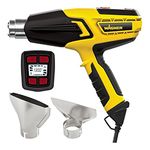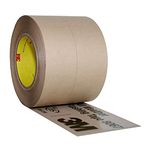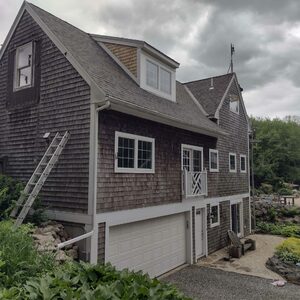An argument for left-handed saws
John Spier’s survey of sidewinder circular saws was well researched and presented (FHB #141, pp. 54-59). But after he got his first tool-belt full of sawdust, he gave short shrift to southpaw saws.
We need to remember that the only reason circular saws are configured motor-to-the-left, blade-to-the-right is that the motors have a counterclockwise rotation. They were originally made that way because all stationary power saws had a counterclockwise rotation. Stationary power saws had a counterclockwise rotation because all saw-mill saws were built that way. And sawmill saws were built that way … In other words, there is no good reason for the configuration: It just “growed” that way and became the standard.
Ten years ago, when I was in the market for a new worm drive, my local tool guru persuaded me to try the Porter-Cable left-handed sidewinder, which is now the PC347. What a revelation! It was a good
5 lb. lighter than any worm drive, and I could see the alignment marks and cutline easily because the blade was on the left side of the motor, just like a worm drive.
The saw is a lot less tiring to use. I am not constantly hunched, twisted and arched just to get a glimpse of the cutline on the other side of the motor. The left-blade configuration allows for much straighter posture and less tension in the shoulders and back from having to twist in the odd position required to use a right-bladed saw.
There are some differences in technique with this saw, but nothing serious. The most significant is that like a worm drive, the saw table, and thus the weight of the saw, is on the waste portion of the cut. This fact means you have to have positive control of the saw as you finish the cut. A right-handed sawyer will also find that thumbing the guard out of the way requires some changes in hand and finger alignment, but nothing difficult to get used to. After a while, it becomes natural.
I would never go back to a right-handed saw. The left-bladed circular saw is just too easy to use.
One word about the Porter-Cable 347 specifically. The blade guard works well for just about all stock at nearly all angles, but the guard jams when cutting 1×4 stock unless you adjust the depth of cut to 7⁄8 in., which many carpenters avoid doing because of the time it takes. Every other 1-in. width seems to cut without a problem.
Other than that, I have used Porter-Cable saws for a decade and, having looked at the competition through John’s eyes, see no reason to consider changing. Of course, if someone would marry a DeWalt back grip to a Milwaukee front grip, a Hitachi motor and a Porter-Cable table, and add the Bosch auxiliary guard retractor—then we would have a great saw.
—J. M. Edgar, via e-mail
You’ve got to remove the dry rot
In the “Breaktime” section of the June/July issue (FHB #140, p. 16), there is a discussion about replacing a rotted sole plate that warrants some comment.
All the dry-rotted material must be removed. Sistering on new studs without removal of the dry rot will result in the contamination and rotting of the new studs. Removal of the moisture source will not kill the dry rot. It is an organism that will keep growing until it is removed.
Also, the new sole plate should never be notched. The existing bolts should be cut off, and the foundation should be drilled to accept new 10-in. by 5⁄8-in. dia. bolts epoxied into the holes. Because they’re retrofits, the bolts should be spaced a maximum of 48 in. o. c. except in areas of a shear wall, where they should be 16 in. o. c. And the ends of the existing sole plate should have an anchor bolt within 12 in. of the end.
If there is damage to existing shear-wall plywood, the plywood should be replaced with a piece of like material a minimum of 24 in. above the foundation. The edges of the patch should all be nailed to 2x blocking, and the bottom of the existing cut plywood and the new piece should be nailed to match the existing shear-wall plywood.
If the existing studs are to be toenailed into the new sole plate, they may require predrilling to prevent splitting.
I know this sounds like a lot more work, but I think it’s the difference between a permanent repair and a temporary one. Having dealt with this repair on several occasions, I know it’s tempting to take shortcuts, but doing it right the first time is easier in the long run. I guess I’m too old and too lazy to want to do it twice.
—Don Waller, via e-mail
Claims grouting tile with a grout bag makes more sense
In your April/May issue, there was an article about grouting tile (FHB #138, pp. 68-73), and this time I had to write. Grout is not best put on with a shovel and a wheelbarrow only to be wiped off with great effort. It is my firm belief that troweling the grout over the tile in hopes of getting some of it a little way into the joints is about as inefficient as one can get. In fact, just a few pages on in the April/ May issue, there was a much more enlightened author using a grout bag to get the stuff in (“Refacing Concrete Steps With Brick,” p. 98). Using a grout bag and filling the grout lines from the bottom up makes much more sense.
—Mark Havel, via e-mail
Another product for slippery floor tile
The question on p. 22 of your last issue (FHB #141, “Q&A”) had to do with solving the problem of slippery bathroom tile. Our Home Depot sells a product called Slip Guard made by Slipguard Worldwide (Hialeah, FL; 800-327-5052). It is a one-part mix and is extremely easy to apply using a stiff brush. It’s invisible after application. It leaves a thin rubberized coating that appears to be skidproof. We have used it in our stall shower and are very satisfied. The manufacturer does suggest reapplication in about one year in shoe-traffic areas and in about 18 months in areas where you go barefoot. One pint of Slip Guard should be enough for two shower areas.
—Frank Simon, via e-mail
Another suggestion when installing shower pans
I enjoyed Tom Meehan’s article on installing leakproof shower pans (FHB #141, pp. 66-71). We follow essentially the same procedure except for one new detail. After having our first leak and ceiling repair, we’ve now added one simple step to our testing method to ensure we know the true source of a leak. Before connecting the drain and plugging it for testing, we first fill the uncut pan and wait a few days before draining and making the connection. This way, if there is a leak, we can be assured that the pan itself is not the culprit and that the problem is with the drain connection. Saves some head scratching and a new pan.
—Ron Cascio, Eastern Shore, MD
Kudos for covering safety issues
The June/July 2001 (FHB #141) issue of Fine Homebuilding contained an outstanding number of quality articles about health and safety issues for builders. Besides the excellent features about prevention of skin disease and about particulate filter masks, there was a wealth of practical information on health and safety throughout the issue. From drywall lift/handling methods to describing a new guardrail holder to cautionary tales of injuries and near misses, this issue was excellent.
Your readers may be interested in some additional resources available from our Web site (www.dhs.ca.gov/ohb/hesis), including Guide to Getting Medical Care for Job-Related Pain That Won’t Go Away, Drywall Installers: Prevent Back, Wrist, Neck and Shoulder Injuries (coming in 2001) and Using Solvents Safely.
I hope that you continue to serve your readers so effectively in this important aspect of building.
—Dr. Jim Cone, Occupational Health Branch, California Department of Health Services
More tips for painting plastic
One of your readers asked about painting plastic in your last issue (FHB #141, “Q&A,” pp. 20, 22), and the answer was not that definitive. I realize that there are many plastics out there and that my method will not work on all of them. But I can tell you that I have had great success with XIM primer (XIM Products Inc.; 800-262-8469) on plastics with a topcoat of Sherwin-Williams Superpaint.You can also check the auto-body suppliers; they have some unusual products. I once painted plastic bifold doors with some primer I got at an auto-body store.
—Al Hernandez, via e-mail
Suggests better product for drainage behind exterior trim
The article “Exterior-Trim Details That Last” by John Michael Davis, in the August/September issue (FHB #141, pp. 60-65) highlights many interesting tricks of the trade by the author to provide rot-free detailing of exterior trim. One of his solutions uses Enkamat 7010 to create a drainage plane behind exterior trim. Enkamat 7010 is a turf-reinforcement mat manufactured by Colbond Inc. for use in the erosion-control industry. Undoubtedly, the author has used it with success.
But as the manufacturer of this product, we wanted to let the record show that this is not the intended use of this particular product. However, we have developed other products for these applications and recommend them to your readers. Enkamat 5006 and Enkamat 7004 have been specifically designed to provide the drainage plane described in the article by Mr. Davis.
—Richard Goodrum, technical marketing manager, Colbond Inc., Enka, NC
Owl statuette scares birds
Our experience with birds slamming into our windows has been different from those reported by Irene Fedun in your annual HOUSES issue (FHB #139, “Commentary,” pp. 26, 28, 30, 32). We had the problem of daily bird hits after we bought our house on Colorado’s western slope until we bought a black metal owl, which we hung in one of three large windows.
The birds stopped hitting the windows immediately, even though these are modern reflective windows. Perhaps a small owl-shaped silhouette is scary to birds, and the hawk silhouettes Ms. Fedun referred to simply don’t work. Whatever the reason, we have not had to remove any more stunned and dead birds from our deck.
—Gene Goffin, via e-mail
Fine Homebuilding Recommended Products
Fine Homebuilding receives a commission for items purchased through links on this site, including Amazon Associates and other affiliate advertising programs.

Handy Heat Gun

8067 All-Weather Flashing Tape

Affordable IR Camera






















